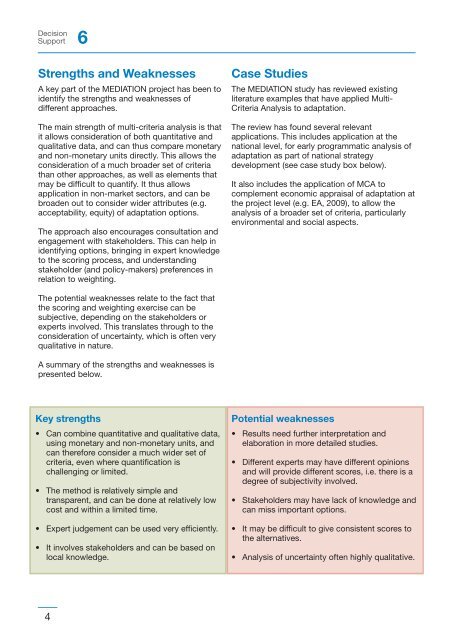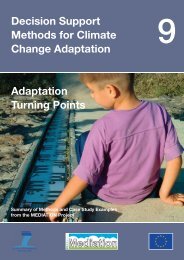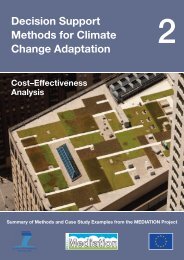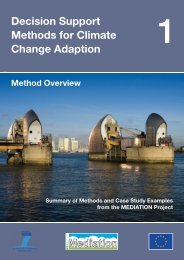Download all Technical Policy Briefing Notes in a single ... - Mediation
Download all Technical Policy Briefing Notes in a single ... - Mediation
Download all Technical Policy Briefing Notes in a single ... - Mediation
- No tags were found...
You also want an ePaper? Increase the reach of your titles
YUMPU automatically turns print PDFs into web optimized ePapers that Google loves.
DecisionSupport 6Strengths and WeaknessesA key part of the MEDIATION project has been toidentify the strengths and weaknesses ofdifferent approaches.The ma<strong>in</strong> strength of multi-criteria analysis is thatit <strong>all</strong>ows consideration of both quantitative andqualitative data, and can thus compare monetaryand non-monetary units directly. This <strong>all</strong>ows theconsideration of a much broader set of criteriathan other approaches, as well as elements thatmay be difficult to quantify. It thus <strong>all</strong>owsapplication <strong>in</strong> non-market sectors, and can bebroaden out to consider wider attributes (e.g.acceptability, equity) of adaptation options.The approach also encourages consultation andengagement with stakeholders. This can help <strong>in</strong>identify<strong>in</strong>g options, br<strong>in</strong>g<strong>in</strong>g <strong>in</strong> expert knowledgeto the scor<strong>in</strong>g process, and understand<strong>in</strong>gstakeholder (and policy-makers) preferences <strong>in</strong>relation to weight<strong>in</strong>g.Case StudiesThe MEDIATION study has reviewed exist<strong>in</strong>gliterature examples that have applied Multi-Criteria Analysis to adaptation.The review has found several relevantapplications. This <strong>in</strong>cludes application at thenational level, for early programmatic analysis ofadaptation as part of national strategydevelopment (see case study box below).It also <strong>in</strong>cludes the application of MCA tocomplement economic appraisal of adaptation atthe project level (e.g. EA, 2009), to <strong>all</strong>ow theanalysis of a broader set of criteria, particularlyenvironmental and social aspects.The potential weaknesses relate to the fact thatthe scor<strong>in</strong>g and weight<strong>in</strong>g exercise can besubjective, depend<strong>in</strong>g on the stakeholders orexperts <strong>in</strong>volved. This translates through to theconsideration of uncerta<strong>in</strong>ty, which is often veryqualitative <strong>in</strong> nature.A summary of the strengths and weaknesses ispresented below.Key strengths• Can comb<strong>in</strong>e quantitative and qualitative data,us<strong>in</strong>g monetary and non-monetary units, andcan therefore consider a much wider set ofcriteria, even where quantification isch<strong>all</strong>eng<strong>in</strong>g or limited.• The method is relatively simple andtransparent, and can be done at relatively lowcost and with<strong>in</strong> a limited time.• Expert judgement can be used very efficiently.• It <strong>in</strong>volves stakeholders and can be based onlocal knowledge.Potential weaknesses• Results need further <strong>in</strong>terpretation andelaboration <strong>in</strong> more detailed studies.• Different experts may have different op<strong>in</strong>ionsand will provide different scores, i.e. there is adegree of subjectivity <strong>in</strong>volved.• Stakeholders may have lack of knowledge andcan miss important options.• It may be difficult to give consistent scores tothe alternatives.• Analysis of uncerta<strong>in</strong>ty often highly qualitative.4





